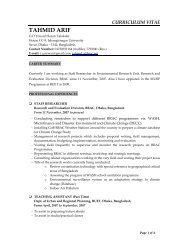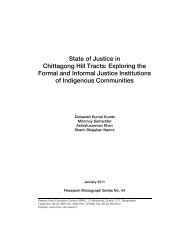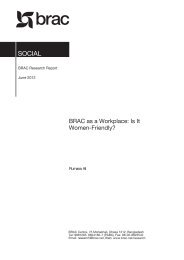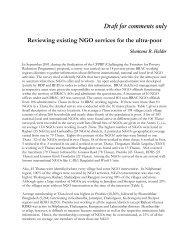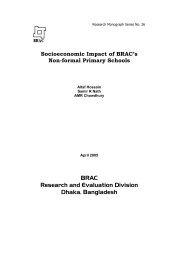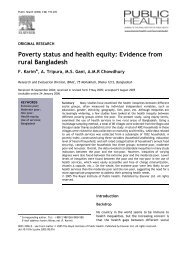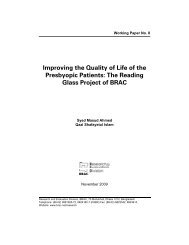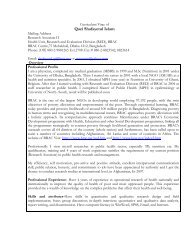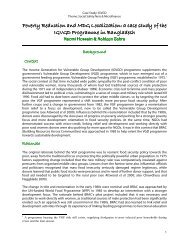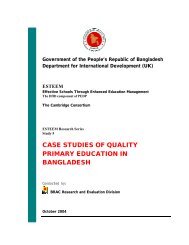Combining health and social protection measures to reach the ultra ...
Combining health and social protection measures to reach the ultra ...
Combining health and social protection measures to reach the ultra ...
You also want an ePaper? Increase the reach of your titles
YUMPU automatically turns print PDFs into web optimized ePapers that Google loves.
Research resources<br />
that many public donors may be used <strong>to</strong>. This is a very<br />
important point <strong>to</strong> underst<strong>and</strong>. As discussed below, in<br />
practice effective PPPs operate more like a cross between<br />
<strong>social</strong>-VC funders <strong>and</strong> multinational drug company (MNC)<br />
divisions.<br />
Just as VC firms do when looking for optimal new products<br />
<strong>to</strong> take forward from a commercial perspective, <strong>the</strong> PPP also<br />
assesses <strong>the</strong> field <strong>to</strong> hone it down <strong>to</strong> a shortlist of <strong>the</strong> most<br />
promising R&D projects from a public <strong>health</strong> perspective.<br />
The PPP raises <strong>the</strong> funds, bears <strong>the</strong> risks, finances <strong>the</strong><br />
chosen groups, provides support <strong>to</strong> get <strong>the</strong>ir products across<br />
<strong>the</strong> line, <strong>and</strong> finally reaps <strong>the</strong> (<strong>social</strong>) dividend. Likewise, <strong>the</strong><br />
PPP plays a VC-like role in setting miles<strong>to</strong>nes, moni<strong>to</strong>ring<br />
progress against <strong>the</strong>se <strong>and</strong> making go/no-go decisions based<br />
on how well each project performs. PPPs are assisted in this<br />
task by <strong>the</strong>ir Scientific Advisory committees, composed of<br />
experts (often world-leaders) in industry pharmaceutical<br />
development <strong>and</strong> developing world <strong>health</strong> needs. Watching<br />
one of <strong>the</strong>se committees grill R&D groups on <strong>the</strong>ir projects is<br />
a fascinating exercise in how public <strong>health</strong> <strong>and</strong> industry<br />
expertise can work <strong>to</strong>ge<strong>the</strong>r <strong>to</strong> ensure that <strong>the</strong> target products<br />
are not only possible from an industrial perspective, but also<br />
optimal in terms of affordability, suitability, efficacy <strong>and</strong> safety<br />
for <strong>the</strong> target developing country populations.<br />
This VC-like role is often unacknowledged, which is a great<br />
pity since it is an area where government funders of R&D<br />
projects (for example, via grant programmes) are often most<br />
exposed <strong>to</strong> <strong>the</strong> risk of poor investments <strong>and</strong> failed decisions.<br />
Shifting <strong>the</strong>se decisions <strong>to</strong> PPPs with industry <strong>and</strong> public<br />
<strong>health</strong> expertise represents a clear bonus for government<br />
funders. If allied <strong>to</strong> additional government funding of PPPs, it<br />
could also help provide <strong>the</strong> magical formula of increased<br />
public involvement <strong>and</strong> accountability, but decreased public<br />
risk. An important proviso is that <strong>the</strong> PPP must, of course,<br />
have sufficient industry <strong>and</strong> public <strong>health</strong> expertise – some<br />
groups are stronger on this than o<strong>the</strong>rs, an issue that is<br />
addressed through proposals set out elsewhere .<br />
PPPs also play a role that we have loosely categorized as<br />
“MNC-like”. In o<strong>the</strong>r words, <strong>the</strong>y provide smaller or less<br />
experienced drug development partners with technical <strong>and</strong><br />
scientific skills that <strong>the</strong>y may lack <strong>and</strong>, importantly, provide<br />
overall management of <strong>the</strong> lengthy <strong>and</strong> complex drug<br />
development process. MNCs often play a similar role when<br />
working with small biotech companies. For instance, PPPs<br />
can supplement <strong>the</strong>ir partner’s skill gaps by arranging (<strong>and</strong><br />
often funding) outsourcing <strong>to</strong> Contract Research<br />
Organisations (CROs), by finding industry partners for fur<strong>the</strong>r<br />
development, or by putting <strong>to</strong>ge<strong>the</strong>r manufacturing deals with<br />
o<strong>the</strong>r firms. These activities closely mimic <strong>the</strong> modular<br />
approach that MNCs increasingly take <strong>to</strong> drug development,<br />
keeping core activities in-house but outsourcing o<strong>the</strong>r jobs <strong>to</strong><br />
contracted groups who can do <strong>the</strong>m more cheaply.<br />
PPP assistance of this nature can be invaluable for<br />
academic groups, developing country firms with limited<br />
experience of registering novel drug products (as opposed <strong>to</strong><br />
generics) or biotech firms who are strong in drug discovery<br />
but have limited, if any, experience of regula<strong>to</strong>ry approval or<br />
large-scale manufacturing <strong>and</strong> distribution. In each of <strong>the</strong>se<br />
instances, <strong>the</strong> PPP can contract in <strong>the</strong> necessary skills <strong>to</strong> fill<br />
<strong>the</strong> gap (e.g. a CRO skilled in <strong>to</strong>xicology or regula<strong>to</strong>ry<br />
approvals; a developing country company with experience in<br />
large-scale manufacture) <strong>and</strong> provide overall management of<br />
PPPs<br />
Cumulative direct<br />
R&D spend<br />
US $76m*<br />
34.8<br />
Academics<br />
30.2<br />
SMEs/CROs/<br />
DC firms<br />
35%<br />
Big pharma<br />
One third<br />
translation<br />
of research<br />
in<strong>to</strong> drug<br />
leads<br />
Two thirds<br />
<strong>to</strong> industry<br />
* – Covers period 2000-2004<br />
– PPP R&D spend only (<strong>to</strong>tal PPP spend was Us$112 million)<br />
– TDR figures are excluded<br />
SMEs: Small- <strong>and</strong> Medium-sized Enterprises, CROs: Contact Research Organisations DC: Developing Countries<br />
Figure 3: Resource allocation by PPPs 2000-2004<br />
142 ✜ Global Forum Update on Research for Health Volume 4




